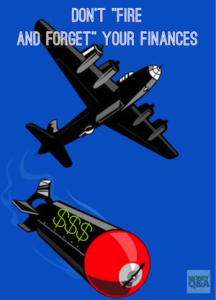
Far too many of investors often choose the path of least resistance. After we finally overcome the initial roadblocks and start investing for retirement and other financial goals, many of us get set in our ways. We let our investments run their course without following up with them or even checking on the periodically.
You must find a balance in investing. Where do we draw the line in being too involved versus having a hands off approach? We have to find that middle ground.
Deep down, we all know that we should have some checks and balances with our investments. Here are a few times when you should look back in on your investments.
Look at Your Asset Allocation
Are your investments unbalanced with more bonds or more stock than you planned? With the recent fluctuations in the stock market over the past few weeks, many investors find their asset allocation, their asset class percentages, misaligned from their plan.
You should look at rebalancing your portfolio at least once a year. The mix between stocks, bonds, cash equivalents, and other investments that you have cannot simply be set on autopilot and forgotten about. You need to relook it every so often.
A couple of good tactics and techniques that many employ are the simply rebalance your investment portfolio after the New Year. I know other investors who like to look at their investment mix around their birthday. It’s an easy date to remember for most of us, although many may not like the reminder of getting older.
Whatever tool you use or date you set, put it on your calendar. Have you had a great year with your stocks? Are you underweight in bonds for your target? Find time to rebalance your portfolio once a year.
Dollar Cost Averaging Is a Great Tool
Most of us have heard that we should pay ourselves first and place investing for retirement and our other financial goals high in our budgeting priorities. And, dollar cost averaging is a great tool to accomplish that goal.
With dollar cost averaging, you invest a set amount of money each month in an investment regardless of that investment’s share price. In some months, you will pay a higher amount for few shares with rising share price. But, other months, you’ll be able to purchase more shares with the same amount thanks to lower share prices.
Over the course of a long time horizon, your costs will start to average out to a middle range, hence the name, dollar cost averaging. Typically, your total costs will be lower on a per share basis than had you simply just tried to time the markets.
This investing strategy also allows you to break the inertia of not investing. You don’t have to think about it. It’s easy. Your investment company simply takes out an automatic payment each month from your bank account, in most cases, to fund your investments, taking you out of the equation altogether.
One problem with dollar cost averaging is that people tend to let their investments run because they do not have to make any changes, input, or purchase orders. Once again, it’s the path of least resistance. It’s the lazy way of investing, and many people simply let it continue to run its course.
This isn’t necessarily a bad thing if you have chosen the right investments. But, no investment, no matter how you purchase it, should be just “fire and forget”. You need to continue checking up on your investments periodically, even the ones you use dollar cost averaging to purchase.
Is the mutual fund manager staying within his stated investment guidelines? Is the company whose shares you purchased still have the same strategic goals and vision, which made you purchase the company in the first place?
No investment should be a dumb bomb. You’ve got to track them like a TOW Missile. Don’t “fire and forget” your investments. You don’t have to watch the markets and your investments everyday. But, stay engaged every once in a while.
Review your investments and your plan. Reallocate your investments when needed. You be happy you did.
Do you have a habit of “firing and forgetting” about your investments? What tactics and techniques do you use to break the inertia and intervene in your finances?
